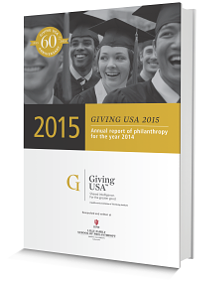Originally published as the Foreword of Giving USA 2015: The Annual Report on Philanthropy for the Year 2014, available now at www.givingusa.org.
It all comes down to two numbers: 60 and 358.38 billion.
And it’s hard to say which is more remarkable. Is it the annual report about charitable giving, started in a very different era—the 1950s, when the yearly household income was slightly more than $3,000 and a TV set was a status symbol—that not only survived for 60 years, but has become the most reputable resource of its kind? Or is it that, in a milestone year for Giving USA, the results hit a new record in total estimated giving—$358.38 billion? Together, these historic numbers mark a new era of philanthropy. For perspective, compare the $358.38 billion given in 2014 with total estimated giving in 1955—$7.14 billion. When you adjust for inflation, the total was $63.13 billion. How philanthropy has grown!
Once you read these highlights from our seven decades of research, from the history of charitable giving to what we see on the horizon, you’ll realize just how many numbers it takes to change the world.
First, the big question: how was giving in 2014? In a nutshell, it was a very good year. Of course, there’s more to the story. Giving USA 2015: The Annual Report on Philanthropy for the Year 2014 presents many levels of data, some of it surprising and much of it inspiring.
Not only did 2014 donations eclipse the previous high-water mark (the $355.17 billion donated in 2007), they also increased across every category of donor: individual, bequest, corporation and foundation. The economic variables that drive giving decisions differ by category, so this across-the-board growth from every corner of society is encouraging and hopefully indicative of a healthier economy—one where support for our nation’s 1-million-plus nonprofits is considered not only a priority, but worth digging deeper into our respective pocketbooks.
The more things change, the more they remain the same—at least when it comes to who donates to charity. From the very first edition of Giving USA, individuals have been, and continue to be, a giving juggernaut. Their share has been approximately three-quarters of the total – or more — year-in and year-out. And, when you consider that donations from bequests and family foundations also are from individuals, the share jumps to almost 90 percent of all giving. So, while on the outside, America looks very different today than it did in 1956, it’s clear that on the inside, our heart for giving continues to beat strongly.
The flip side of where charitable donations come from, of course, is where they go.A key component of every edition of Giving USA is how giving fared among nine different types of nonprofits. Our research and analysis examines changes in giving from both the prior year as well as over time, and the 2015 edition is just as detailed. We selected some highlights we hope you agree are pertinent to the story of philanthropy in 2014.
Last year, estimated giving to eight out of the nine categories increased; on top of that, total giving for two-thirds of them hit a new record. While the overall growth is indicative of robust philanthropy to a wide spectrum of nonprofits and, thus, of boats rising with the tide, it’s also important to examine trends and patterns that could have affected the totals.
Religion—which reached a new record last year of $114.90 billion in charitable gifts—accounted for the largest percentage of donations, as it has since Giving USA started. However, this category is continuing a dramatic 30-year downward trend as a percentage of total giving. In 1987, its share of the total was 53 percent; in 2014, it was 32 percent. Last year’s share grew 1 percent over 2013’s estimated 31 percent of total giving.
A variety of factors can be attributed to this decline: fewer Americans identify with a religion, church attendance is down, and people are giving more to organizations with religious values that match their own, instead of, or in addition to, congregations.
International giving declined in 2014 – and was the only category to do so. The $15.10 billion donated last year was 2 percent less than 2013’s revised estimate of $15.41 billion. This marks the third year since 2010 where giving dropped. There were no major disasters last year, which might have impacted donations, but the unanswered question right now is if it will continue to decline, or if the last few years are an anomaly.
 Giving to foundations went up 1.8 percent in current dollars, to $41.62 billion, making 2014 the fourth straight year where donations increased. Foundations account for a growing share of the philanthropic landscape, and there are more and more of them. In fact, a quarter of the larger U.S.-based foundations didn’t even exist before the year 2000.
Giving to foundations went up 1.8 percent in current dollars, to $41.62 billion, making 2014 the fourth straight year where donations increased. Foundations account for a growing share of the philanthropic landscape, and there are more and more of them. In fact, a quarter of the larger U.S.-based foundations didn’t even exist before the year 2000.
What trends are having an impact on charitable giving?
Future giving can’t be predicted with precision, but there are some trends we’ve been keeping an eye on that seem to be asserting themselves in terms of their importance to philanthropy. Some considerations:
- Nonprofits have been receiving very large gifts from high-net-worth households. These contributions are worth noting because we believe they are starting to account for a lot of the growth in individual giving. This trend accompanies the fact that while the total number of donations made annually to charities isn’t changing much, the average gift size from individuals is going up.
- Nonprofits are being asked more and more to be accountable for what they do with donations. And on the whole, nonprofits are responding with transparency.
- Even though donations from individuals to several large donor-advised funds didn’t grow dramatically in 2014, overall this vehicle for giving has grown in terms of both dollars and importance over time, and we think that pattern will continue.
- Just like society at large, nonprofits are not immune from the rapid pace of technology. Consider that not too long ago, online and mobile giving were unheard of; other recent innovations that are changing how nonprofits and donors engage with each other include social giving startups and crowd-sourcing models. And, campaigns that employ hashtags, like #GivingTuesday, are becoming commonplace.
- Tech entrepreneurs who are part of the millennial generation are among the individuals who, in 2014, decided they could make best use of their wealth by giving some of it away. While the jury is still out on longer-term behavior among this age group, we hope their giving behavior encourages fellow millennials to become philanthropists, much like The Giving Pledge served to challenge the peers of Warren Buffett and Bill and Melinda Gates. It definitely bears watching.
- Across the universe of donors, there is more and more interest in learning what strategies are being used by nonprofits they support, as well as what impact their donations are having. In response, nonprofits are collecting data so they can report back to their stakeholders on what matters to them.
- While metrics can help improve accountability, nonprofits also know the importance of intangibles — that people give to charities whose work they believe in, have a passion for, and are familiar with – and they use that knowledge to develop ways to inspire and engage donors.
A public trust for 60 years – and beyond
For 60 years, we have served as the most comprehensive report available on American philanthropy, a public trust we take very seriously. These data and insights can be used to immediately inform and improve the work of nonprofits, as well as help the public understand the role philanthropy plays in society—and the role they themselves play in total giving.
We hope Giving USA will continue to serve the philanthropic community as a guide and compendium for another 60 years. At this particular milestone, please accept our thanks for the continued generosity that keeps our country’s nonprofits vibrant and viable.

